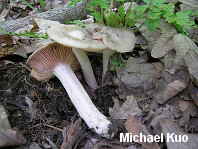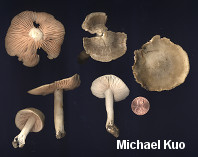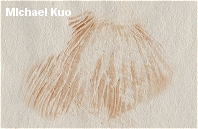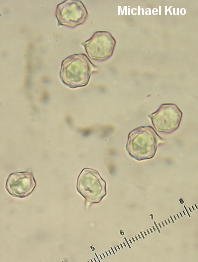| Major Groups > Gilled Mushrooms > Pink-Spored > Entolomatoid Mushrooms > Entoloma griseum |

|
Entoloma griseum [Basidiomycota > Agaricales > Entolomataceae > Entoloma . . . ] by Michael Kuo Entoloma griseum is a medium-sized springtime species with a dull, brownish gray cap that is not pointy like the caps of several other vernal entolomatoid mushrooms. The cap is fairly fragile, and develops a silky sheen as it dries out. Other distinguishing features include the mealy odor and taste; the whitish to grayish gills that become pink with maturity; the whitish stem, which develops hollow pockets with age; and microscopic features (see below). My treatment of Entoloma griseum may or may not agree with your field guide's treatment--or in one case, it may agree with the photo but not with the description. See the explanation below if you care. Description: Ecology: Saprobic; growing alone, scattered, or gregariously under hardwoods in low, wet woods; limited to spring in my area (central Illinois), but reported in Michigan by Kauffman (1918) from "May to October"; apparently limited to eastern North America. Smith, Smith & Weber (1979) report it "in late August and September . . . in rather dry upland hardwood stands." I suspect there are several species involved--a vernal species from low, wet areas (described here), and one or more autumnal species from dry woods. The latter may actually be, at least in part, Entoloma grayanum (Peck) Saccardo, which is very similar. Cap: 4-9 cm; convex with a slight central bump, becoming broadly convex or nearly flat, but usually retaining a slight bump in the center; at first firm, but soon fragile and thin; tacky but not slimy when fresh, becoming dry and silky; brownish gray to silvery gray, fading to buff as it dries out, often resulting in a mottled appearance (hygrophanous); the margin not prominently lined but sometimes faintly lined when wet. Gills: Attached to the stem; close or nearly distant; whitish or very pale gray at first, becoming pink with maturity. Stem: 3-9 cm long; 4-15 mm thick; more or less equal; fairly dry; bald; whitish to pale grayish; "its interior . . . composed of a fibrous pith at first which disappears in places leaving cavities" (Kauffman, 1918). Flesh: Thin; fragile; whitish to grayish. Odor and Taste: Mealy. Chemical Reactions: KOH on cap surface negative. Spore Print: Pink. Microscopic Features: Spores 8-11 x 6-8 µ; 5- and 6-sided; smooth; inamyloid. Hymenial cystidia absent. Pileipellis a cutis with occasional upright elements; elements hyaline to brownish in KOH. Clamp connections absent. REFERENCES: Peck, 1904. (Saccardo, 1912; Kauffman, 1918; Hesler, 1963 [not 1967]; Smith, Smith & Weber, 1979; Phillips, 1991/2005 [see comments below].) Herb. Kuo 05079502, 05070401, 05070704. In 1904 Charles Peck described Entoloma griseum, the mushroom treated above. He had described a different mushroom, "Leptonia grisea" (1893), a few years earlier. When mycologists later folded Leptonia into Entoloma, the result was two species with the same name. Hesler's 1967 treatment of "Entoloma griseum" is actually a treatment of Peck's Leptonia, and therefore bears the official name "Entoloma griseum (Peck) Hesler," since Peck was the original author of the species name, but Hesler put the species in Entoloma. However, this created a conflict with Peck's Entoloma griseum--a mistake Hesler later realized and corrected (1974) by simply providing a "nom. nov." (new name) for the taxon: Entoloma squamatum. "Entoloma griseum Peck," the mushroom featured on this page, has not changed its name since it was first described. It is featured in Saccardo, 1912 and thoroughly described in Kauffman (1918). Smith, Smith & Weber (1979) treated Entoloma as "Rhodophyllus," and their "R. griseus (Peck)" is an incorrectly made, unofficial combination into Rhodophyllus--although the mushroom they describe, along with Helen Smith's illustration, does correspond to Peck's Entoloma griseum (which they say they include "because it is an example of a ubiquitous mushroom easily confused with half a dozen other species in the genus some of which are poisonous"). Roger Phillips (1991/2005) provides a photo that appears to match Peck's Entoloma griseum and the photos above--but his description follows Peck's Leptonia grisea and is correctly labeled "Entoloma griseum (Peck) Hesler." To verify my claim, note among other things that Phillips cites the width of the stem as "3-4 mm," clearly not matching the more robust stems in the photo. I suspect that Phillips took photos of specimens correctly identified as Entoloma griseum by others at a mushroom foray, and later consulted the Hesler monograph when writing text for his book, without noticing the problem. This site contains no information about the edibility or toxicity of mushrooms. |
© MushroomExpert.Com |
|
Cite this page as: Kuo, M. (2014, January). Entoloma griseum. Retrieved from the MushroomExpert.Com Web site: http://www.mushroomexpert.com/entoloma_griseum.html |



